There’s a sea of barley, the horizon a shadowed thin night cloud line of trees. In the late afternoon heat this far from the coast there’s no wind, no air sucked in by the heated land to move the thorned tops. Everything is calm. The summer hasn’t advanced enough to ripen it to pale greyed golds. You feel you could swim silently in the unshifting pale green of it. The stems still flex, not yet a crackle around your legs, spring back with water drawn up, powered from the sandy soil below, the yearly cycle still filling up the grains. Come the time, bleached it will be cut and threshed out, blowing dust across the last of summer, then malted for beer and ground for fodder, seed in the endless cycle.
I wade into the margins, just enough to lose my my lower legs. The earth is dry, in it scattered the plough smashed shards of flint. One eyes me back, a bend away; the familiar glowing bulge of a blow, it’s a hand struck flake, the edge picked at, chipped away like a saw blade. I turn it in my hand in the sunlight, it hums silent and dark, a black song of the past against the blue and green.
I studied this field in an aerial photograph, there were suspicious crop marks. I thought possibly ploughed-out barrows or ring ditches. I’ve checked the records, there is nothing noted. The marks are filled and ploughed in marlpits, the lines are shadows of old hedgerows lost to the machines sometime after 1946 when aeroplanes crisscrossed the country, recorded everything in stark black and white. The tithe maps echo the same story. There is surprisingly little here, and yet so much, a gap in the county in a place that seems even more deserted now. An old rectory, the church, a farm or two commanding a faint rise in the low swells and faint troughs of the Norfolk countryside.

The church is on a bend, cupped in the trees, just birdsong and lazy insect drone. The graves are canted and pleasantly lost in long sedges and grasses, a gate long since rotted out, and entry via a sloping cut. It’s quite small, a nave, barely a chancel, a single aisle, the tower is small and plain, nicely proportioned leaning against the body of the building, framed against the sky by the trees. The air around is filled with bees, a colony in swarm either leaving or settling, my camera freezes them in the air like falling ash.
The name Witchingham initially suggests early-Anglian/Anglo-Saxon, it’s could be an ~ingas, like Sheringham, ‘the people of’ with the additional ~ham. The Witch~ suggests maybe Wych Elms or possibly a person’s name. There’s also a vague and tempting suggestion here. Could the name relate to wīcing~ or pirates and seamen; conjecturally the Vikingr. Even inland these sea-related names are not as uncommon as they might appear and are visible in the similar etymology of the sailor or pirate hinted at in the Aescmann at Ashmanhaugh and the Flotman in Newton Flotman. Strangely here it might be more in step with the nearby landscape of rumoured battles between King Edmund and the Great Heathen Army near Lyng. The settlements are recorded as Wicinghaha and Wittcingehem in Domesday, the church itself has evidence of Anglian in the North Wall, in a building that’s largely later Anglo-Norman.
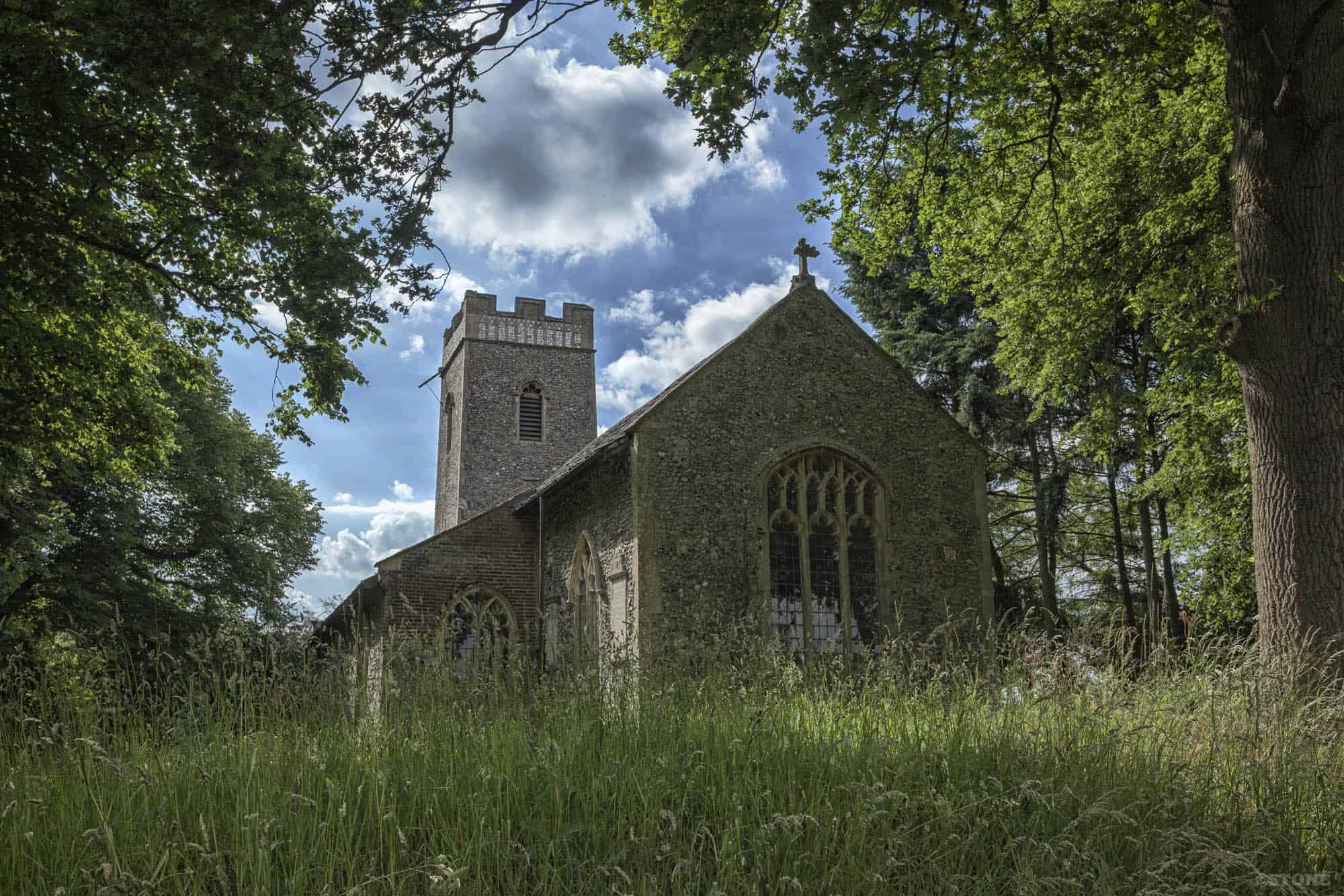
There’s something enticing about the inner coolness of these spaces – the thick walls. in this case built of flint at a point where heading west the rust-coloured carstone inclusions start to appear, picked from the ground as the deep landscapes change. The thickness of this old matter suspends the growing heat as we progress through our new flexible and scarily unpredictable summers.
I’ve read a little about St Faiths over the years. The building has had a life constructed around the elastic population of a parish that stretches back beyond its foundation. Farmers, tenants, smallholders, families. It’s small and would have seen both full congregations and the later emptiness. It has overseen both people and trees, which at one point grew inside, weeds stretched to the light. It has saved us, and we have saved it. I’ve seen the inside in photographs, but nothing quite prepares you for a good cold-water shock, the reality of it almost makes me gasp. It’s cool, arcaded on one side, a font base against one pillar, another replacement font bought in from Whitwell in the aisle. A lecturn, a ladder. One chair positioned with a hand-written card inviting you to sit and view should you so choose.
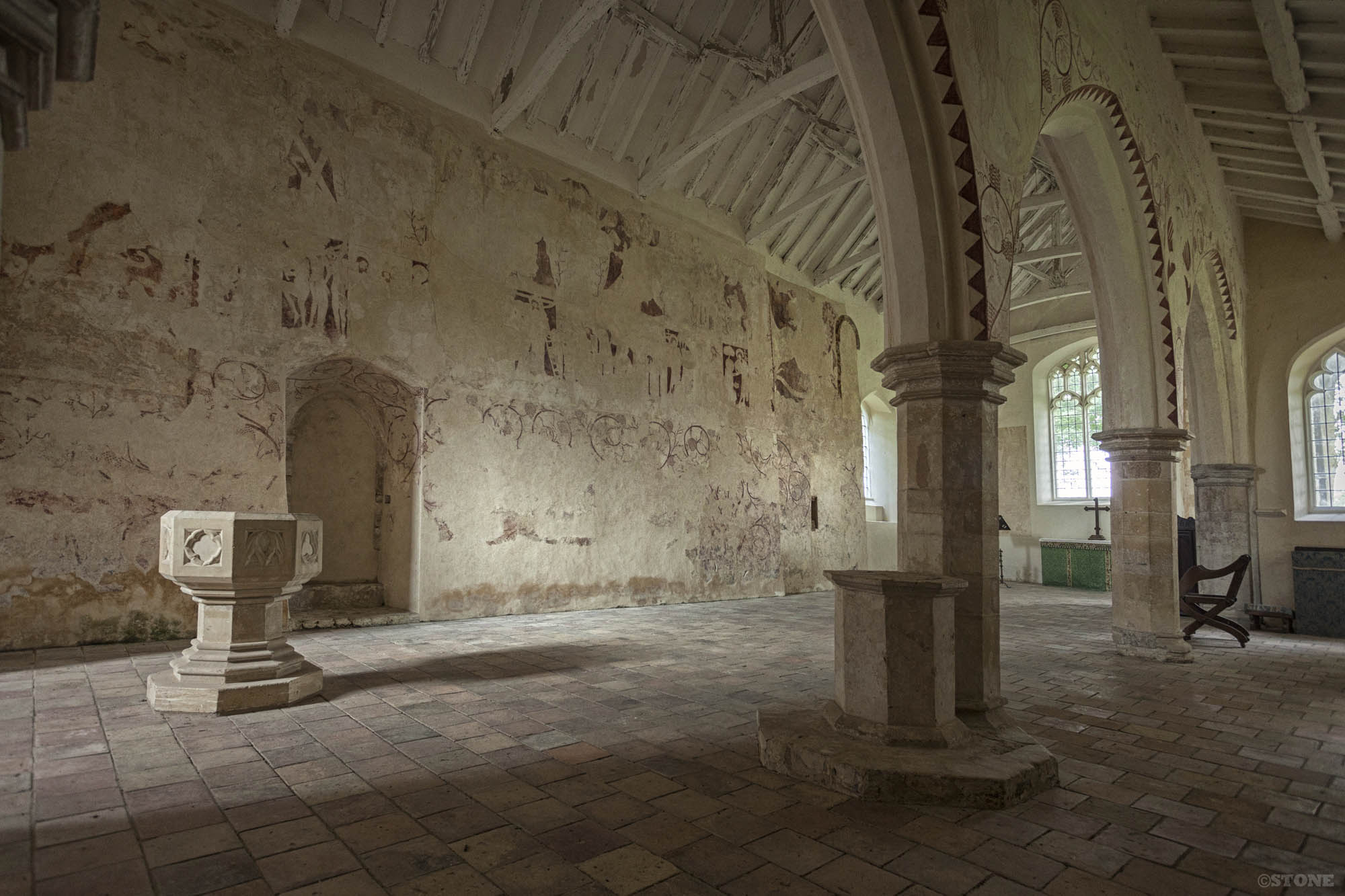
The paintings are stunning, a camera can’t do them justice, this is very much a thing for the eye, but then really isn’t everything. They date from the early to middle 14th century. Only the red paint has truly survived, it appears to be red ochre rather than unstable, expensive and poisonous vermillion, a mercury sulphide. Blue and green were rarer and not evident, but there’s traces of black and yellow ochre too when you get close, soil, ash and charcoal suspended in egg binding it to the walls. The reds are powerful and don’t fade. One thing that strikes me always is how unlike modern ink this is, where a mass produced print in a charity shop window or a day lit wall will first lose its magenta to the sun, go green and the gradually lose its yellow fading to black and cyan. The conditions here have left a skeleton of red. It would have, at its peak have been a pretty full sensory experience for a largely illiterate congregation, picture book tableaux of the passion of Christ, Saint George and the Dragon, saint’s emblems and what look like either vines full of grapes or hops twist and curl. There’s the remnant of three living and three dead too. Patterns dogtooth arches. The whole thing feels curiously like looking at and decoding decaying negatives.
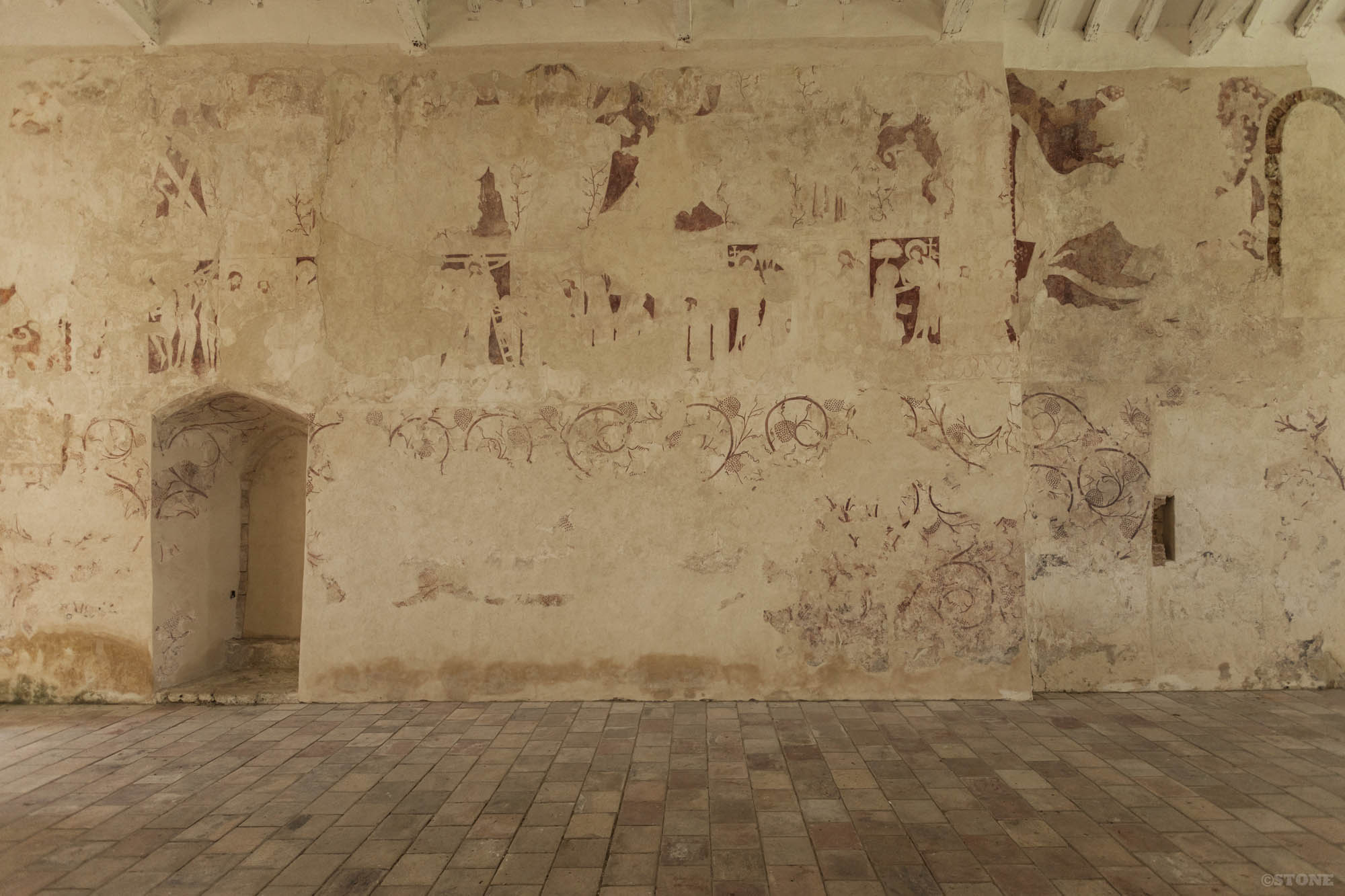
One wall is free of paint. A hint at something believed to hark to one of the great desertions of the human landscape. The wall was prepped, ready to take the unfurling waves of colour. Then in 1348 and 1349 the great plague came. It was neither the first or the last wave, but certainly a great tsunami that emptied these fields and churches. It removed farm labourers, painters, builders, artisans and their families. Lords and priests, rich and poor all equal under the scythe of the death the disease brought in the folds of its cloak across the land. The painting remained incomplete, then eventually as our patterns of belief shift – painted out; a distraction to modern eyes in the sixteenth century; the focus changed from what the world around said to what the church wanted you to hear. Patterns like these obliterated by steadfast grim-faced shifts in the patterns of law and thought, then forgotten for centuries beneath layers of lime-wash.
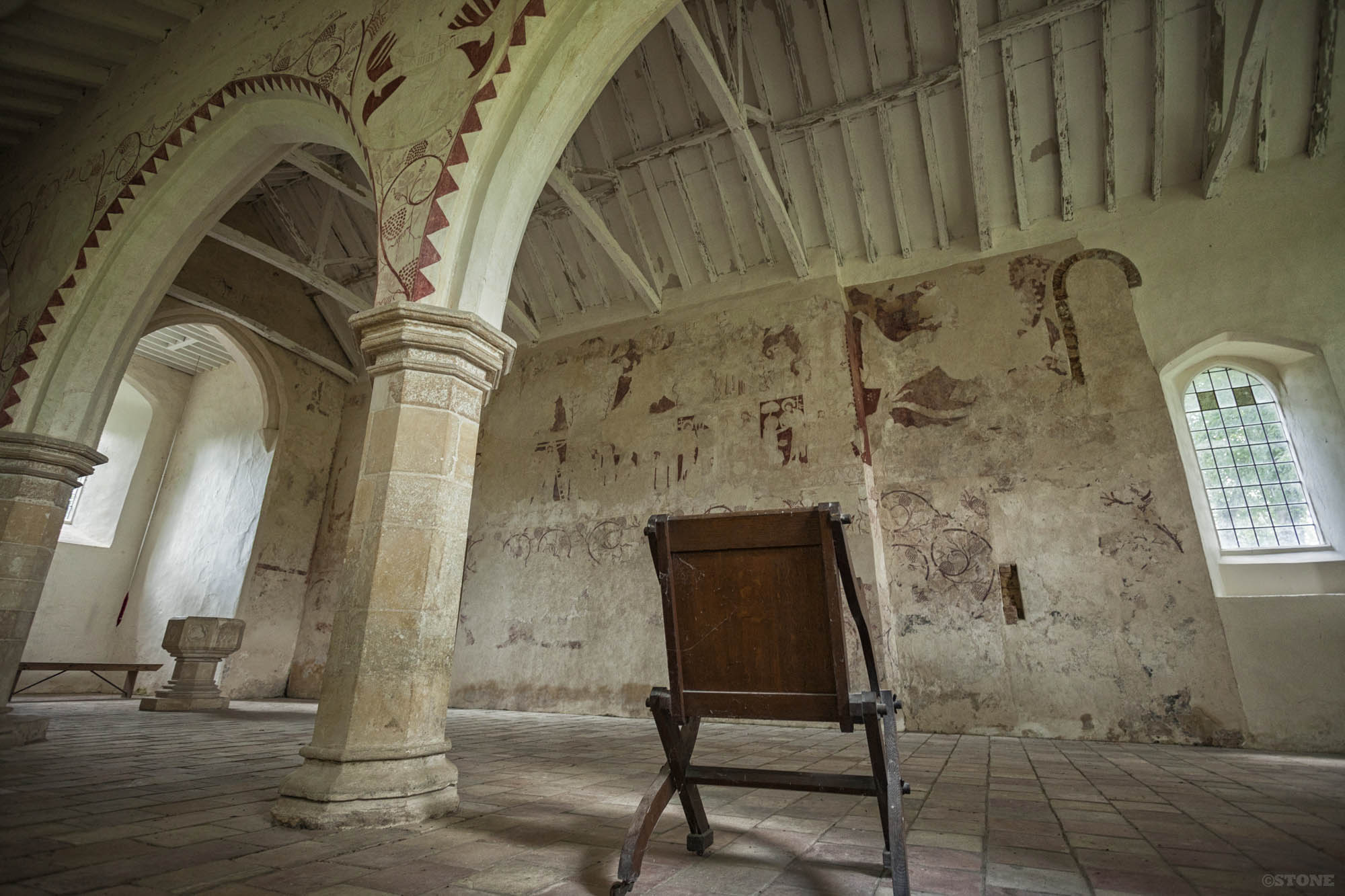
Like so many in our countryside the church gradually fell out of use; started to deteriorate, it did so more than once, modified in the 1790, one aisle reduced, re-roofed. The Victorians changed a window; all ages modify things to their view of how a something should be rather than what it is. Then the 20th century nearly destroyed it completely; closed in the 1920s, redundant, ignored and falling to pieces, the roof collapsed, nature broke in, trees grew through. In 1945 plans were made to remove the church and rebuild it in nearby Bawdeswell. Ultimately it was rescued in a blink, by luck I think. At some point in 1974, Eve Baker the Historian and conservationalist chanced upon the ruin, climbed through a hole, peeled some ivy back which pulled away some damp limewash revealing the colours beneath, an electrifying discovery. Norfolk Churches Trust were instrumental in clothing the body and dealing with the revelation, the Churches Conservation Trust have continued to look after it since.
It is remarkable, a chance to really look back at a different time in detail. Fragmented as it is, it tells not just the story of what we believed, but how. It also tells the tale unwittingly perhaps of how life ebbed and flowed over the landscape around this little building in an island of trees and grass in the sea of barley.

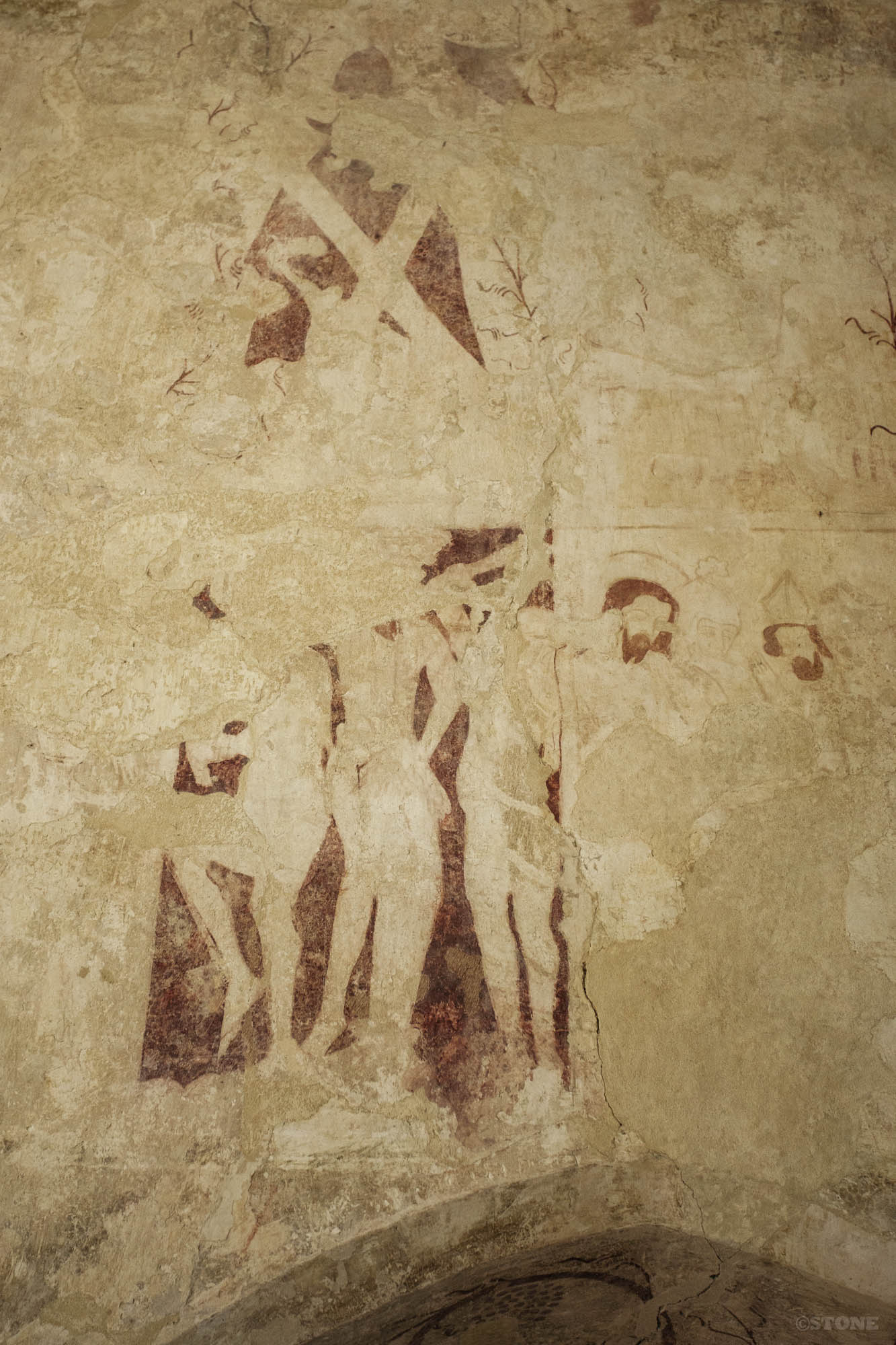
Lose my breath
Keep coming now
Possessed of nothing more than hell
Before I can speak
My world is wishing me asleep
Weigh me down
And when the darkness comes around
Repeating heads
Remember nothing I have said
Where are you
Come back again, I want you to
“Not now, girl”, you say
But I was born to lose my breath
Bilinda Butcher
References and links:
Simon Knott – Norfolk churches here and also here.
CCT – Little Witchingham

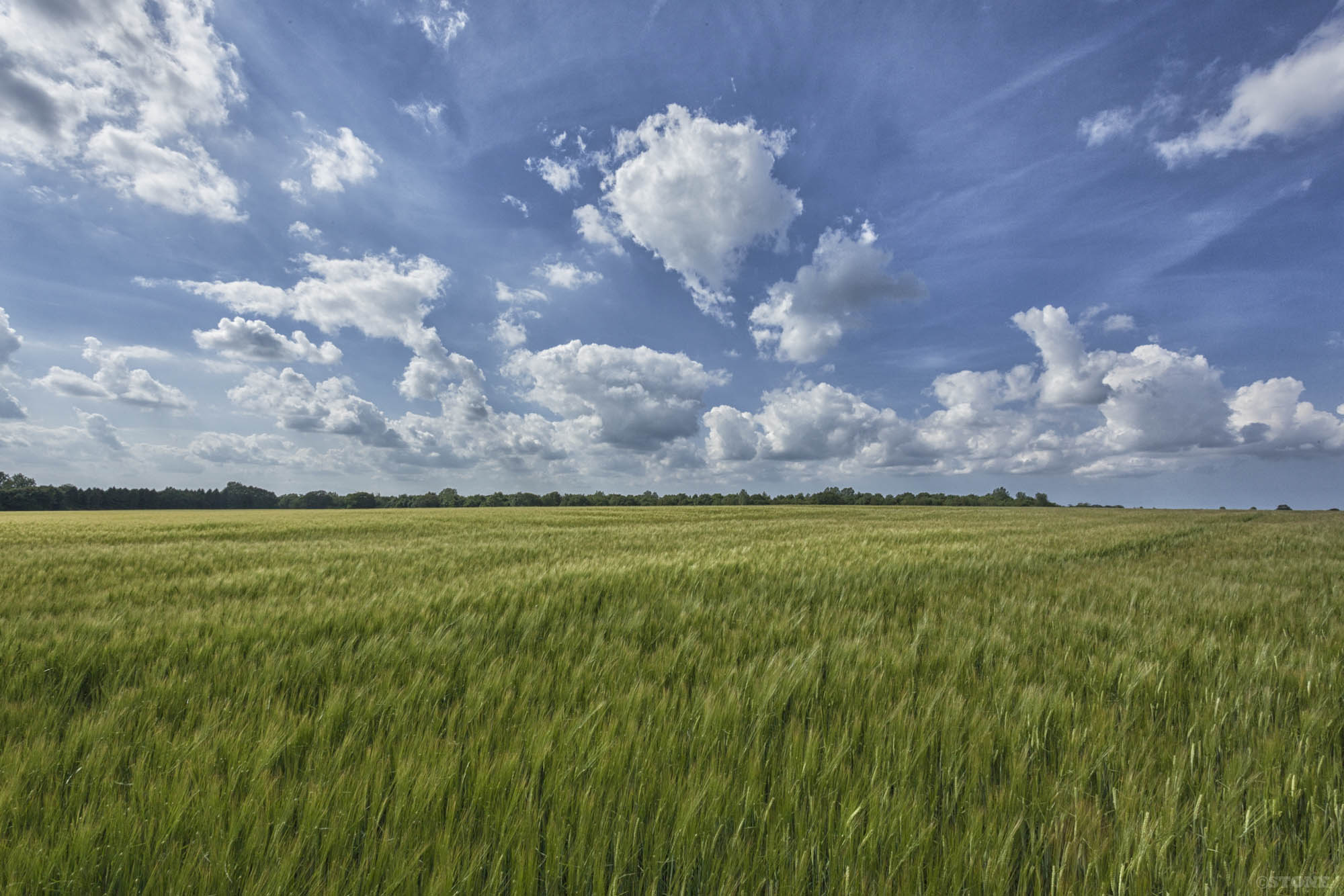
Great article / post Nick. I didn’t know the story of how the church was saved – some similarities there with Houghton on the Hill. I really like those paintings and that the church is unencumbered by furniture, allowing a clear view.
A friend and I have visited St Faith’s at least 6 times; indeed; always when we need our spirits refreshed. There is a fragility and holiness about the building emphasised by its architecture and emptiness. The frescoes are a special gift. The Church is a masterpiece to be ever preserved.
This is brilliant writing, full of insight.
Lovely photographs and beautiful writing